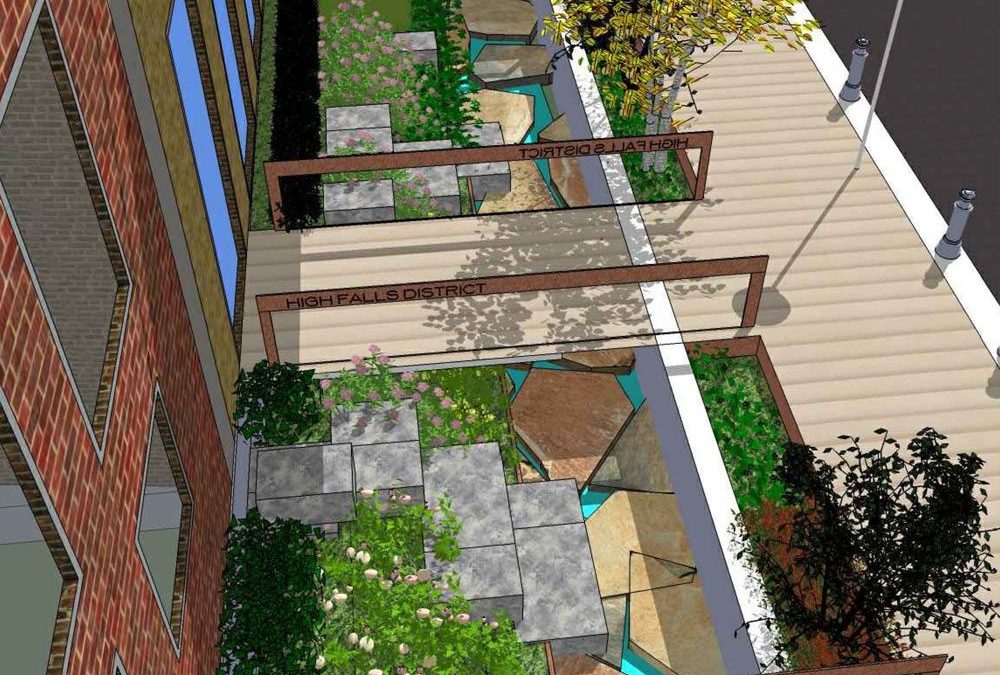
by Diana Louise Carter | Saturday, April 23, 2016 | FlourGarden, GardenAerial, Greentopia
At last. The FlourGarden has been completed for several months. But the first week in May, Delta Fountains of Jacksonville, Florida, will come to Rochester to start up the garden’s waterworks and program the fountains and lights. It won’t be the dancing waters of Bellagio, but it will be pretty special. Delta Fountains’ many major projects of national acclaim include both the September 11th Memorial Fountain in New York City and the Oklahoma Memorial Fountain in Oklahoma City. Oh, and there have been quite a few splash parks in between, as well as water features on New York City’s High Line, too.
To celebrate, we at Greentopia will host a grand opening for the FlourGarden, Tuesday, May 17th at 10:30 a.m. There will be a ribbon-cutting ceremony and comments from dignitaries gathered at Brown’s Race, the street that is home to both our offices and the FlourGarden. We encourage well-wishers to come to the event to show support for this first leg of Greentopia’s big vision, the GardenAerial, a series of gardens and amenities surrounding High Falls. This spring the first plants — native to the area — will blossom as, we hope, the GardenAerial takes root, too.
And if you enjoy this little event, stay tuned for the much larger Garden Party, May 22, following in our tradition of really cool events. Come join us as we grow.
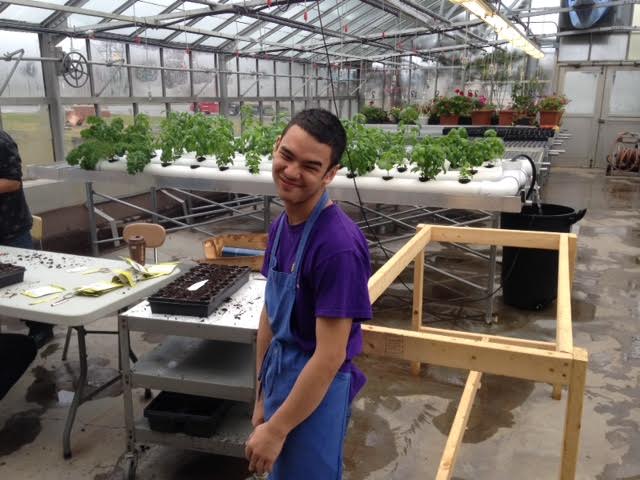
by Diana Louise Carter | Friday, April 15, 2016 | Green Visions, Greentopia
Green Visions is planting new seeds. Not just the kinds that produce great cut flowers, but the kinds that produce opportunities for a new group of youth – developmentally disabled students at Edison Career & Technology High School.
The program has partnered with Edison’s Buildings & Grounds Careers program on a pilot project in three ways:
- Students recently planted 5,000 seeds in the Edison greenhouse that will be transplanted into Green Visions’ gardens in the JOSANA neighborhood later this spring.
- Two students from the program have been selected to be among the 15 interns who participate in Green Vision’s job training by working 20 weeks, from May through October, in the cut flower gardens in northwest Rochester.
- Another six to eight students in the program will come as a group to the Green Visions gardens once a week for 10 weeks, too. Their performance as volunteers will help identify future interns, who are paid a stipend for their work.
“One of the major hurdles for people with a disability is getting that first job,” said Lewis Stess, co-founder of Greentopia. So far, most graduates of the Green Visions programs have gone on to jobs, but not within the landscaping field, Stess said. But the students from Edison may be an even better fit for this kind of landscaping work. “They could become great gardeners, great landscapers, great bouquet-makers,” he said.
Meanwhile, Green Visions has just been recognized by the Rochester region chapter of the Sierra Club with its annual Environmental Leadership Award. Morgan Barry and Tiani Jennings, managers of Green Visions, accepted the award April 21.
This latest accolade and the new partnership with Edison come at a time when Green Visions is ramping up its ability to serve commercial accounts. Last year Green Visions provided 15 bouquets a week to Wegmans’ East Avenue store. This year the order has been upped to 100 bouquets shared among three Wegmans stores.
“We’re going to be the only local suppliers of cut flowers,” Stess said. “And we supply those flowers from vacant, unused lots.”
Youngsters 18 to 22 who come from the Northwest part of the city will still fill most of the internships Green Visions provides. In a neighborhood like JOSANA, paid internships can be a rare opportunity leading to sustained employment. Besides providing a job reference and experience, the Green Visions program also provides certification in job and environmental safety practices — important credentials for landing another job.
Such training may be even more valuable for Edison’s students. Morgan Barry, program director for Green Visions, noted that the unemployment rate for 20- to 24-year-olds with disabilities is 70 percent nationally, which is double the rate for their non-disabled peers.
Chris McCoy, the Buildings and Grounds Careers teacher at Edison said, “One of the greatest indicators of post-secondary employment for individuals with disabilities is whether or not a student works or volunteers during high school. Community partners such as Green Visions provide a real-life work setting as well as the types of job training skills that are the difference between employment and sitting at home.”
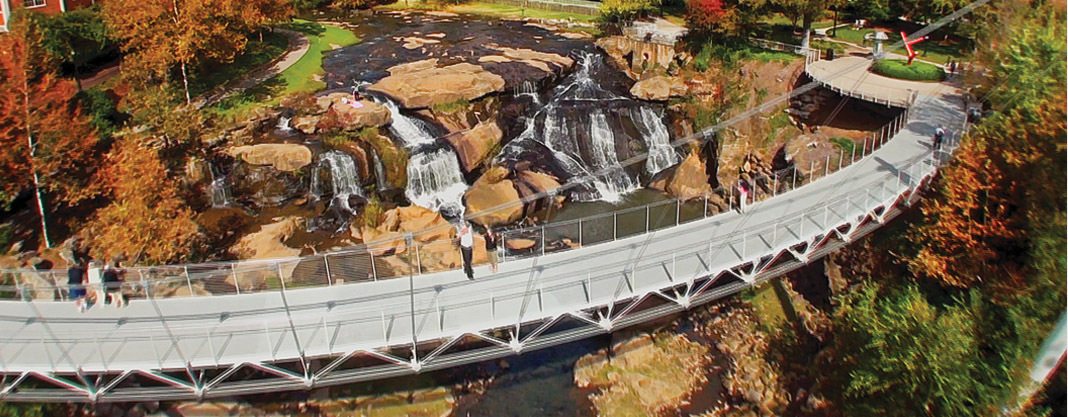
by Diana Louise Carter | Friday, April 15, 2016 | FlourGarden, GardenAerial, Greentopia
Validation is a great thing. Greentopia organizers got plenty of that this month when they met with Mayor Knox White of Greenville, SC, who was in town to speak at the Community Design Center’s annual Reshaping Rochester luncheon. Greentopia was a sponsor of the event.
White’s talk sounded like he was describing Greentopia’s plans for Rochester: “How a River Acts as a Community Connector.” But he was really telling the story of how redevelopment of the small Reedy River – a brook, really, with a 20-foot-tall waterfall – in Greenville because the catalyst for a revitalized and vibrant downtown.
“It changed downtown Greenville in ways no one could imagine,” said Lewis Stess, co-founder of Greentopia. “What we found most interesting is the direct parallel between our experience in Rochester and Greenville”, he said. Like in Rochester, where many natives and long-time residents have never seen or spent any time at High Falls, Greenville residents were unaware of the water asset in their community. Like in Rochester, some people felt the river was in an unsafe part of town. And, like in Rochester, redeveloping the river wasn’t a priority for public and private officials at first.
Once Mayor White, a corps of garden club members, and others persuaded city council to remove a four-lane highway bridge over the falls and build a pedestrian bridge instead, people began to see the possibilities. Knox was in the beginning of his second term as mayor when he was finally able to push the project to approval.
Now the 20-acre Falls Park on the Reedy River is the jewel of the city, an economic engine, and THE most popular spot for people to walk and picnic.
“The diversity is just unbelievable…families just flock to it,” White told the host on WXXI’s Connections with Evan Dawson show a week before his visit to Rochester. (Hear the podcast here.)
Stess said Falls Park has become the place visitors to town are taken as soon as they arrive. Clemson University recruits people by taking them to downtown Greenville before visiting the campus 20 miles away. Greenville’s downtown now thrives with restaurants, galleries, apartments and hotels. All that took 20 years to happen, but Greentopia, which has invested five years so far in the GardenAerial project at High Falls, is hoping for a quicker turnaround in Rochester. The FlourGarden, the first part in a series of gardens and features that surround the falls, was completed at the very end of 2015 and will have it’s grand opening in early May, 2016.
Stess said White was stunned when he viewed Rochester’s 96-foot waterfall. “Each city must find its own gem”, White said, and he was looking at Rochester’s.
“If you have water and a waterfall… it is kind of obvious that makes your city so unique and different,” White said in his radio appearance. “We always tell people: Find your waterfall…find what makes your city unique and different.”
Greentopia found what makes our city unique. Greentopia champions it, day in and day out. Now the rest of Rochester can, too.
by Diana Louise Carter | Thursday, March 10, 2016 | EcoDistrict, FlourGarden, Futures Summit, GardenAerial, Green Visions, Greentopia
February 18, 2016, marked the fifth anniversary of Greentopia’s incorporation. So what does our five-year-old organization have to show for those years? Plenty!
- Four years of free Greentopia festivals to raise awareness of sustainability and green assets in downtown Rochester, bringing more than 50,000 people (many for the first time) to High Falls.
- Four years of Film Festivals to call attention to green issues and sustainability.
- Three Futures Summit conferences, bringing in speakers from around the country to talk about urban sustainability and green redevelopment.
- Purchase of a large section of the High Falls cataract to preserve it as part of the GardenAerial project.
- Three years of Green Visions, a job training program that has provided 20 weeks each year of job training and employment for young people in the JOSANA neighborhood, while producing beautiful gardens to beautify the neighborhood and provide cut flowers to sell.
- The beginning of New York’s first EcoDistrict, a district that will share ideas and green projects to work and live more sustainably in and around the north side of downtown Rochester.
- Awards and recognition, including being named a “top priority” transformational project by the Sustainability Workgroup of the Finger Lakes Regional Economic Development Council.
- A massive Dinner on the Bridge, calling attention to and raising money for Greentopia’s initiatives, including the GardenAerial circling the canyon around High Falls.
- The completed FlourGarden: a running water, native plants garden with sculptures and lighted fixtures on Brown’s Race, the very first capital development project of the GardenAerial.
- Hundreds of thousands of dollars in grants from the Finger Lakes Regional Economic Development Council; Metabolic Studio; The Farash Foundation; The Community Foundation; Daisy Marquis Jones Foundation; and New York State Energy Research and Development Authority (among others).
- And the support of hundreds of individual and corporate donors for events, programs, and capital projects. Won’t you join with us?
And we’re just getting started.
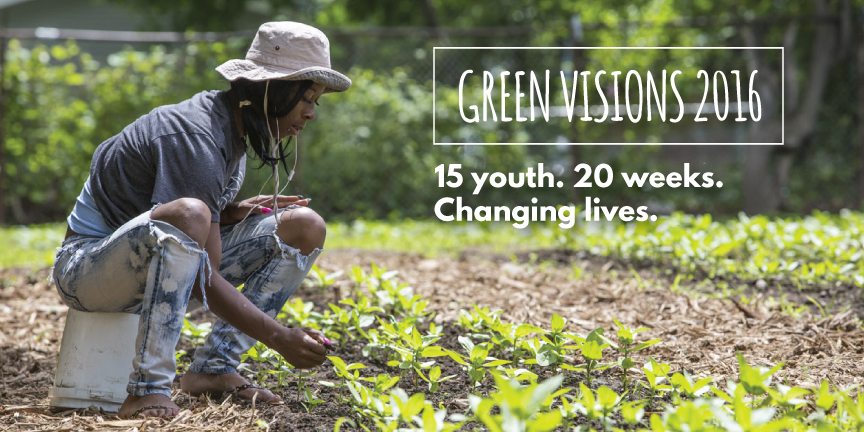
by Diana Louise Carter | Tuesday, February 2, 2016 | Green Visions, Greentopia
February is Green Visions month! Just as people in are turning to seed catalogs to dream about what they’ll grow in the spring and summer, Greentopia is planting new “seeds” to ensure that Green Visions continues to thrive. And, by the way, they’re also ordering seeds.
Until now, this workforce development and neighborhood beautification program has been supported primarily by grants and gifts. But grants tend to be short-lived and often unrenewable. That’s true whether the program has measurable success, as Green Visions does or not. So Greentopia is taking the month of February to work on making make Green Visions more sustainable financially. What does that mean?
First, imagine changing someone’s life for $3,500. That’s what it costs to provide professional landscaping, construction, and safety training for one Green Visions worker, as well as a stipend for 20 hours of work per week for 20 weeks. The young people who complete the Green Visions program come from one of the poorest sections of Rochester, where jobs and job training that can lead to greater things are often pretty scarce. “It’s not just that these kids will be ready to do landscaping. They’ll be ready to work,” said Michael A. Philipson, co-founder of Greentopia.
Sponsorships will include perks, such as a community-service or team-building opportunities on site for the sponsoring company or group, and display of the company’s logo on signage at the Green Visions sites and in publicity materials and online.
“Ideally, we’re hoping that businesses large and small will look at it as an opportunity for sponsorship,” said Morgan Barry, manager of Green Visions. Businesses or individuals who can’t afford the full price to sponsor one trainee would be welcome to sponsor at more modest levels, Philipson said.
Meanwhile, Green Visions is also moving to a more commercial model to become more self-sustaining. Here are some of the steps being taken:
- Acting on the Green Visions business plan.
- Expanding the value and varieties (50 instead of a dozen) of flowers grown on site.
- Talking with current retailers of Green Visions bouquets about expanding sales to other stores.
- Connecting with florists who will buy in bulk at wholesale prices.
- Modernizing methods, such as irrigation and fertilization, to free up workers to handle more profitable duties.
All in all, it’s a great month to be green.
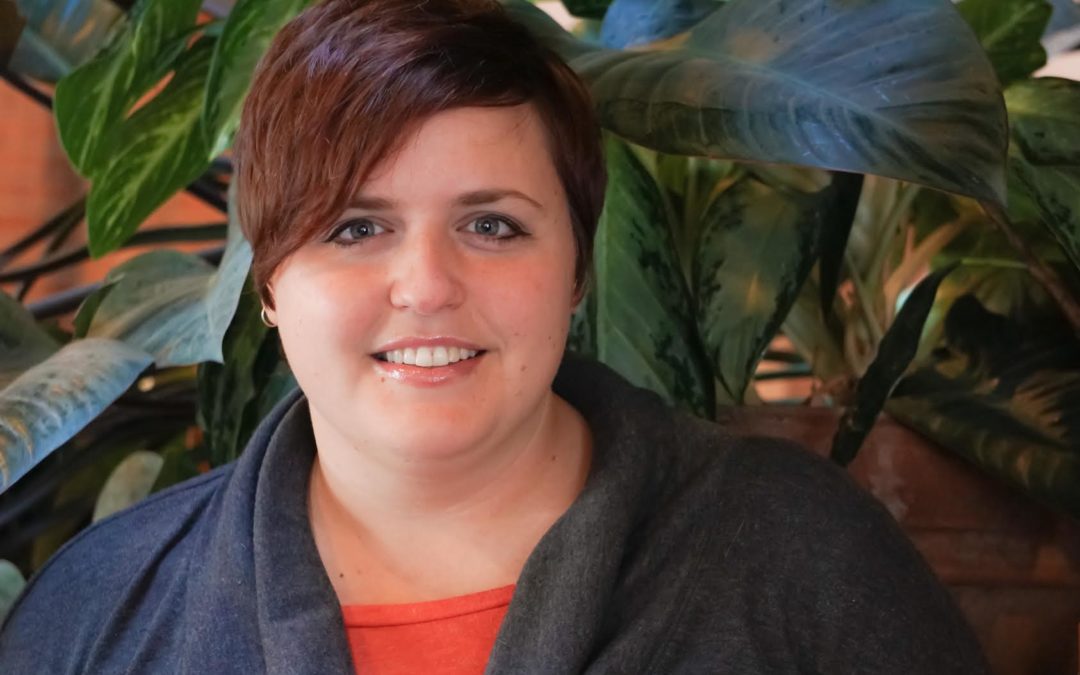
by Diana Louise Carter | Tuesday, January 26, 2016 | EcoDistrict, Greentopia
Rachel Walsh had to go all the way to Seattle to find her next job in Rochester. Actually, she went to Antioch University Seattle’s Center for Creative Change and got what some might think of as the Greentopia degree, though she didn’t know it at the time. But when she saw the job description for manager of the EcoDistrict Greentopia is proposing for Rochester, Walsh told her professor, “Oh my goodness! They made a job of our course list. This is exactly the kind of work I want to be doing.” Having grown up in the Churchville-Chili area, Walsh, 29, found the job both perfectly suited to her new credentials, and a great excuse to move closer to family again.
Before going to Seattle for her master’s degree in environment and community, Walsh earned a bachelor’s degree in horticulture from the State University of New York at Cobleskill and worked for two Rochester-area nurseries.
Walsh began work at Greentopia Jan. 18 and plans to move into an apartment in the Upper Monroe neighborhood with new roommates and her dog, a terrier mix. Even before squaring away her living situation, she was already meeting stakeholders in the EcoDistrict, an overlay district with shared sustainability practices that would lie on both sides of the Genesee River and run roughly from the Main Street bridge to the Smith Street bridge. Her first priorities are developing an outreach strategy for involving stakeholders — business people, city officials and residents — and establishing an EcoDistrict steering committee. A grant from New York State Energy Research and Development Agency is funding the district’s groundwork.
Walsh’s work won’t be all meetings, though, she pointed out, as she’ll rely on community activities (a cleanup perhaps?) to bring people together, too. “People support what they help create,” Walsh said.
Getting Rochester to buy-in on the EcoDistrict — an idea that has taken root in other American cities — could be challenging, Walsh noted. “This is a very progressive project in a very conservative city.” Rochester has many great attributes, Walsh said, naming its arts scene, international cuisine, and cultural institutions. “I would also love to see the green progressive movement be one of the attributes that make Rochester great.”
by Diana Louise Carter | Wednesday, January 13, 2016 | Development, FlourGarden, GardenAerial, Gorge, Green Visions, Greentopia
It’s going to be an exciting year for Greentopia, as we move further into creating some of the physical projects that have been a goal since our inception. Here’s a look at what’s coming:
- Any day now: the FlourGarden will be finished. Final details, such as wood bannisters on metal rails, are being put in this week. The project is the first of several steps to build the GardenAerial, a series of public amenities, infratructure and gardens surrounding the High Falls. Perennial native plants are in, but dormant now. You can also check out our new handrails and water channel. Fountains are there but not visible at the moment. This new amenity will really come alive in the spring, so watch out for our Grand Opening events!
- March through May: Greentopia offers tours of the High Falls area on the first and third Thursdays of each month, weather permitting. You will need to sign-up online and arrive at 81 Browns Race a few minutes before noon to be included in a 30-minute walking tour of the waterfall in a canyon in the middle of downtown Rochester.
Did we mention these are free?
- In April: Green Visions will embark on its fourth year. This is the community program that provides job training and work in the horticultural field for urban youth, at the same time that it beautifies the JOSANA neighborhood in Northeast Rochester. In 2015, this program sold flowers to Wegmans, Hart’s Grocery and customers of the Rochester City Public Market. In 2016, Green Visions hopes to develop a larger commercial customer base and become more self-sustaining. You’ll soon be able to directly sponsor one of our Urban Flower Farmers – a youth from JOSANA neighborhood doing rewarding and meaningful work. The price is affordable even for small businesses.
- May 15: A Garden Party, a brand new fundraiser to celebrate the opening of the Flour Garden. This will be an affordable event seeking to attract a broad range of people to see the newest development at High Falls. Check back here soon to find out more and buy tickets.
- Throughout 2016: Development of the Pont du Rennes. New community interest and opportunities have arisen to make the pedestrian bridge a more important corridor connecting Genesee Brewery and St. Paul Quarter on the east bank and MCC and the Rochester Red Wings games on the west side of the river. As a result, Greentopia will turn its capital development focus on Granite Mills Square and this bridge. Some may recall that when Greentopia held its first GreentopiaFest, creating a park in the sky out of the bridge was one of the bold ideas shared then. Now, with the completion of the FlourGarden, it’s time to get moving on that!
And here’s something you won’t see in 2016 – Greentopia festivals, like the ones offered free for four years. The original festival and the film festival that grew out of it both took lots of time, effort and money, but they were worth it to bring awareness to Rochester’s biggest hidden asset — High Falls. Our founders and board of directors have decided that the time has come to devote those resources to making the GardenAerial at High Falls a reality. The festivals aren’t truly gone, though. Many of their elements (free and low-cost events) will be spread throughout the year, but in a more sustainable way that supports the goal of attaining a vibrant, publicly-accessible realm around the falls. To become a part of that, consider becoming a member.
And look out 2016!
by Diana Louise Carter | Wednesday, December 2, 2015 | FlourGarden, GardenAerial, Greentopia
Imagine sailing over the High Falls on a zip line.
Or if you don’t enjoy white-knuckle adventures, imagine sauntering serenly through an arboretum suspended high above the Genesee River on the Pont de Rennes Bridge. (Those of you who know French just have to pretend that name isn’t redundant.)
These are just two elements of the GardenAerial, an $85 million series of public features to be built around the High Falls. While some sources of funding exist to help out with this huge capital investment in the city’s public realms, virtually no grants keep the lights on and pay the salaries of the people who are leading this vision. And that’s where you come in. This week starts Greentopia’s annual campaign, the effort to pay for some of the overhead that goes into making High Falls more visible and enjoyable for all.
The very first step of the GardenAerial is under construction right now and due to be completed by Christmas Eve: the Flour Garden. The once-leaking raceway along Race Street in the High Falls District has been rebuilt as a water garden. Perennial water plants just went in. During warm months a fountain will flow. And at night, glass rods in the garden will be illuminated, creating a mini-light show.
“We are creating something from nothing,” said Lewis Stess, Greentopia’s CEO and co-founder. “We are progressive, future- thinking.” If you want to help that future arrive, please help. Please answer the email or letter you receive with a donation. If you didn’t get one, please visit our donation page. And dream a little about what’s coming next.
by Diana Louise Carter | Friday, November 20, 2015 | FlourGarden, GardenAerial, Green Visions, Greentopia, Michael Philipson
Greentopia launched a new way to raise funds Nov. 12 with a wine-and-cheese party where people pledged by text. The concept was so successful that the attendees EXCEEDED the entire fundraising goal — $5,000 for the FlourGarden — in less than 20 minutes.
About 50 people attended the event at the Greentopia offices on Brown’s Race. After they saw a film about the GardenAerial project, they were asked to consider making a donation by texting “Flour” to a designated number. Those who did so saw their names scroll across a screen with their pledge amounts, which made others hasten to join in.
“The idea of technology is right to us. It’s more green and engaging,” said Greentopia Co-Founder Michael A. Philipson. And the timing is right. The organization trying to create vibrant public realms has provided four years of FREE Greentopia festivals and events and will continue to offer some free projects to the public. But now it’s time for Rochester to lend its support to this critical work, Philipson said. The FlourGarden, expected to be completed December 24, is the first step in the GardenAerial, a series of park amenities, interactive trails and structures around the High Falls. This first step will cost nearly $1 million and Greentopia is trying to close in on the final dollars for the project.
Philipson said the smartphone app was so simple to use and so successful that Greentopia will most likely use it again to raise money for other projects, such as Green Visions, a job training program reclaiming and beautifying lots in the JOSANA neighborhood, and for a future gala.
To check out the online version, go to our donate page now.
by Diana Louise Carter | Wednesday, November 4, 2015 | Green Visions, Greentopia
Increasingly, it looks like a big part of helping people out of poverty isn’t a hand-out, but a hand up that recognizes the human capital available in our poorer neighborhoods. One program that does this is Greentopia‘s Green Visions program, which provides 22 weeks of job training in the Josana neighborhood during the planting, growing, and harvest season for cut flowers. Members of the Rochester Garden Club recently visited Greentopia’s offices to consider a pitch on a future donation. While they were there, though, they also heard the latest results of Green Visions, which they supported in the past. Though the program creates productive flower gardens one of the most downtrodden sections of Rochester, “ultimately it’s a work development program” Morgan Barry, special projects director, told the garden club. Here are some of the successes he listed:
- 60 percent of the people who participated in summer 2015 secured employment at 12 different businesses when the program was done.
- 94 percent of Green Visions graduates received three types of training and credentials they’ll be able to use to set them apart from other job seekers.
- 80 percent (12 people) of this year’s Green Visions participants began the program without a high school diploma, but a quarter of them earned one while in the program. And half were enrolled in a high school diploma equivalency program during or immediately after their work with Green Visions.
- 15 people completed the program in 2015, representing a retention rate of 87 percent.
- One-third of the 2015 Green Visions participants with high school diplomas are enrolled for the spring 2015 semester at Monroe Community College.
- Flowers were sold directly from the lots, but bouquets also went to Harts grocery store and Wegmans each week, where they typically sold out. The program also sells bouquets at the Rochester Public Market.
by Diana Louise Carter | Tuesday, October 20, 2015 | Greentopia
You’ve heard about the dynamite keynote speakers and, undoubtedly, about the unveiling of a new film about the Garden Aerial, Greentopia’s capital project surrounding the High Falls. But if those attractions haven’t persuaded you to sign up yet for the Futures Summit, here are a few more in the form of distinguished panelists:
Ted Trabue – A fourth-generation Washingtonian, Trabue is managing director of the District of Columbia Sustainable Energy Utility. His 30 years in public affairs, include working as executive director of the Green Builders Council of the District of Columbia and two terms as president of the DC State Board of Education.
Rebecca Salminen Witt — Witt is president of The Greening of Detroit, a 25 year old non-profit environmental organization that works to secure the ecosystem of Detroit, Michigan by coordinating tree plantings, supporting community gardening, providing outdoor education to Detroit schoolchildren and sponsoring green jobs training programs for teenagers and adults.
Susan Spencer – A Rochester native from a Kodak family, Spencer was earning her PhD from Rochester Institute of Technology when she decided to focus on affordable solar power. She founded ROCSPOT to create a solar-powered Rochester, and is a player in national and international solar policy discussions.
M. Andre Primus – Another Rochesterian, Primus has created RocShare, an organization to promote alternative economics such as sharing.
Svante L. Myrick – Ithaca’s youngest mayor and first one of color, Myrick first held political office at age 20, when he was still a student at Cornell University. He was elected mayor when he was 24 and quickly restructured the city government to close a $3 million deficit. He turned the mayor’s parking spot into a mini-park and has renovated Ithaca’s long-neglected pedestrian mall.
Jessica Millman – An expert in urban planning, environmentally sustainable development and smart growth, Millman is a founding member of the LEED for Neighborhood Development Core Committee in the Washington, DC, region. She works on a national level on sustainable neighborhoods and is a leader of the National Resource Defense Council’s Green Neighborhoods Program.
Naomi Davis — Davis teaches a three-semester course in Grannynomics and Green-Village Building at the University of Chicago/Center for the Study of Race, Politics, and Culture. Her heritage as the granddaughter of Mississippi sharecroppers informs her expertise in urban homestead, and mixed-use real estate development. She also is founder and CEO of BIG (Blacks In Green,) a self-sustaining economic development organization in Woodlawn, IL.
by Diana Louise Carter | Friday, October 9, 2015 | EcoDistrict, Environment, Greentopia, Leadership Series
As a travel writer for publications such as National Geographic, Taras Grescoe travels around the world. But he doesn’t own a car. In fact, the Montreal resident says 90 percent of his transit is by foot, bicycle or subway. His keen observations while moving around cities from Moscow to Bogota led to his 2012 book, Straphanger: Saving Our Cities and Ourselves from the Automobile.
Grescoe will be the mid-day keynote speaker at Greentopia’s Futures Summit Oct. 21 at Monroe Community College. While he sometimes uses a car-sharing service in Montreal, he says exercising individual rights by driving cars “is diminishing the commons for everybody.” Personal automobiles hog urban space and make moving around harder for others, he claims, adding that nearly one-third of urban residents don’t or can’t drive a car.
“The biggest obstacle is the presumption that every citizen has access to a car,” Grescoe told a transportation conference in Portland, OR two years ago. “Transit is about mobility, not trains or buses,” he said. Some examples include moving ramps in hilly cities in South America that turn an arduous, 30-minute walk uphill into a five-minute ride. Or the “Mom bike” in Japan, an inexpensive bicycle that allows a parent to peddle along with two children. Or the “cargo bike” in Denmark, where an adult can carry a week’s worth of groceries or up to three children.
Bigger modes of transportation, such as subways or light rail, work best when they’re not competing for space with cars and when they’re speedy and well connected, Grescoe said. He suggests cities go for low-hanging transit fruit by providing services in the more densely populated parts of a city that were perhaps designed for pedestrian traffic before automobiles became ubiquitous in the American landscape.





